solar cells?
solar cells?
Time: 2021-12-24 Editor: goginsor.com Tour: 3307 Times
South of the center of Buffalo (in western New York), near abandoned factories and rundown warehouses, there is a 1.2 million-square-foot white box-like construction that houses Tesla's solar panel factory. New York state gave the local $0.75 billion in funding, mainly because the factory promised to invent nearly 1500 jobs for the local area. On a Tuesday morning in mid-November, two dozen workers were overseeing rows of robots stamping materials for solar roofs, a new type of solar panel that Tesla Chief Executive Officer Elon Musk was thrilled about. Perhaps the harsher version is that it used to be very exciting.
from the planning point of view, the solar roof looks very similar to the ordinary tile roof, but Tesla's solar roof uses textured glass, which is "hidden"solar cell. On the production line at the Buffalo plant, the glass slides on a conveyor belt to a giant laminator, where the components are heated and vacuumed to make a single module that workers call a "solar sandwich". ,
At present, the United States and Japan have the largest market share in the world photovoltaic market. The United States has the world's largest photovoltaic power plant with a power of 7MW, and Japan has also built a photovoltaic power plant with a power of 1MW. There are a total of 230000 photovoltaic power generation equipment in the world, with Israel, Australia and New Zealand leading the way.
1, the global solar cell industry investment status.
the 1990 s, the global solar cell industry has continued to grow at an annual rate of 15%. According to the latest statistics and forecast report released by the Ministry of Dataquest, the total investment in research and development of solar energy in the United States, Japan and Western European industrialized countries reached US $57 billion in 1998; US $64.6 billion in 1999; US $70 billion in 2000; US $82 billion in 2001; Breakthrough $610 billion in 2015.
2011-2015 Global Solar Investment (US $billion)
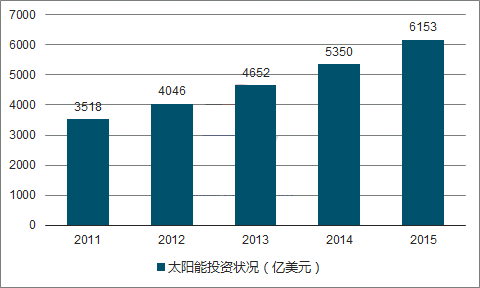
2, China's solar cell industry operation status.
has been, China's solar cell industry is facing overcapacity. Therefore, the solar cell industry needs to develop a diversified consumer market through close integration with related industries and its broad use.
Hanergy Thin Film Power Generation Group Co., Ltd. recently announced that it will invest 7.7 billion billion yuan in Wuhan to build the world's largest production base of gallium arsenide solar cells, with a planned scale of 10 megawatts. Gentle GaAs cells are used in a wide range of applications, including solar cars, mobile phones, unmanned aerial vehicle systems, the Internet of Things and a variety of consumer electronics.
At present, the solar cell industry as a whole has overcapacity, and actively expanding the consumer sector has undoubtedly become an important means to resolve excess capacity. Chang Jinlong, general manager of CCID Consulting Semiconductor Industry Research Center, said that the next few years will be a process of gradual digestion of solar cell production capacity. With technological progress, cost reduction and expansion of consumption fields, it is expected that at the end of the "13th Five-Year Plan" period, excess The solar cell production capacity will be basically solved.
industry and cross-border production of products will become a new trend in the solar energy industry. The combination of solar power generation technology and civil products is becoming more and more vigorous. Facing the increasingly serious energy crisis and air pollution, solar photovoltaic is becoming the mainstream form of new energy in the future. With the improvement of the industrial chain, the consumption of solar energy products is not limited to large-scale electricity consumption, but has become more diversified.
3, China's solar cell supply situation analysis.
of July 2016, China's solar cell (photovoltaic cell) production was 5.701 million kilowatts, an increase of 14.7 percent year-on-year. From January to July 2016, the cumulative output of solar cells (photovoltaic cells) in China was 44.705 million kilowatts, up 26.4 percent year on year. From January to July 2016, the national solar cell (photovoltaic cell) output data table is shown in the following table:
2016 January-July national solar cells (photovoltaic cells) output statistics
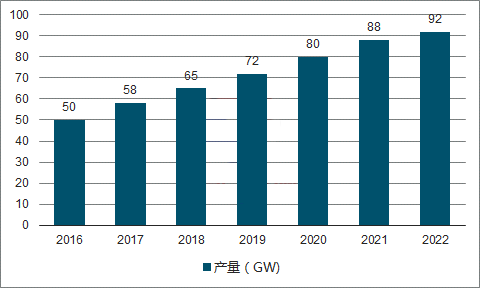
to 2014, my country's solar cell production increased year by year. In 2010, my country's solar cell production increased by 117.04 year-on-year, which was the largest increase in recent years; in 2012, my country's solar cell production growth rate declined to only 14.11; in 2013 The scale of cell production in my country was further expanded, with a production capacity of 42GW and an output of 25.1GW. Compared with 2012, the growth rate is about 20%, and the output accounts for about 62% of the global total output, ranking first in the world. In 2014, China's Communist battery chip 33.5GW, an increase of 31.5. Mainland China and Taiwan account for nearly 80% of the world's share; in addition, Southeast Asia also accounts for about 10%, mainly because Chinese companies have added production capacity in Southeast Asia to avoid European and American trade barriers. About 1/3 of 33GW is installed domestically, while the rest is transferred to export and inventory. In the first half of 2015, the domestic battery production was 18.2GW, exceeding the same period last year, and the solar cell production in China reached 41GW in 2015.
2009-2015 China's solar cell production
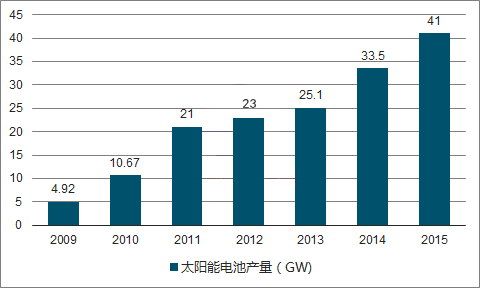
3, China's solar cell technology research and development analysis.
market are mainly produced from monocrystalline silicon. Due to the large energy consumption of monocrystalline silicon battery production, some experts believe that the energy consumption of the existing monocrystalline silicon battery production is greater than the solar energy captured during its life cycle, which is of no value. The most optimistic estimate is that it will take about 10 years to obtain solar energy from monocrystalline silicon cells to be greater than the energy consumed in their production. The single crystal silicon is quartz sand by reduction, after melting pull single crystal obtained. The energy consumption of the production process is large, the toxic and harmful substances are produced, and the environmental pollution is serious. Foreign countries have transferred it to Chinese production. China's large monocrystalline silicon and monocrystalline silicon battery production line.
However, we do not master photovoltaic cell production technology. Although the production technology of monocrystalline silicon photovoltaic cells is very mature, it is still developing, and other photovoltaic cell technologies are also emerging. There is still a big gap between the cost and photoelectric conversion efficiency of photovoltaic cells and the real marketization. The photovoltaic cell market mainly depends on the financial subsidies of governments. The subsidy for photovoltaic power generation in the European market is as high as 1 yuan per degree of electricity. In the future, in order to make large-scale application of photovoltaic cells, we must constantly improve the efficiency and production cost of photovoltaic cells. In this process, the production technology and products will be constantly updated. Its replacement cycle is short, only 3-5 years. Photovoltaic cell production enterprises have large investment and long recovery cycle. Due to the rapid technological update, domestic enterprises, if they do not master the technology and update the technology in time, will soon be eliminated and may not be able to recover their investment.
1, the future of the global solar cell industry pattern
the R & D and industrialization of crystalline silicon Taihang energy batteries in the world, a series of new achievements and breakthroughs have been made. The highest photoelectric conversion efficiency of the high-efficiency monocrystalline silicon solar cell laboratory has reached 24.7 percent, and the highest photoelectric conversion efficiency of the high-efficiency polycrystalline silicon solar cell laboratory has reached 20.3 percent. At the same time, the world's famous universities and research institutions have entered the field of solar energy, advanced technology continues to spread to the industry, so that commercial battery technology has been continuously improved, and greatly reduce the cost of solar photovoltaic power generation. Technological progress has become an important factor in reducing the cost of solar photovoltaic power generation and promoting the development of the crystalline silicon solar cell industry and market. In the future, the solar energy industry will form a tripartite confrontation between the United States and China.
2, solar cell industry trend forecast outlook
solar cells can be divided into crystalline silicon, thin film and concentrating three categories, and concentratingsolar cellhas the highest conversion efficiency, the raw material gallium arsenide is used at a higher cost and is mainly used in the space field. At present, in the international market, the ratio of polycrystalline silicon to monocrystalline silicon solar cells is about 3:1; in the domestic market, the ratio of polycrystalline silicon to monocrystalline silicon solar cells is about 4:1. But that percentage is expected to shrink in the years to come. In distributed photovoltaic power generation, the advantage of using single crystal is very prominent. If the proportion of domestic monocrystalline silicon can be increased, it will further increase the international monocrystalline silicon solar cell market share.
crystalline silicon solar cells can occupy about 90% of the market share is mainly due to two reasons: first, crystalline silicon solar cells have achieved large-scale; second, the conversion efficiency of crystalline silicon solar cells is higher than that of thin-film solar cells. Therefore, the overall cost of crystalline silicon solar cells is lower than that of thin film solar cells. Compared with polycrystalline silicon, monocrystalline silicon has these two points, and there is more room for improvement of conversion efficiency in the future. At present, many power station examples have proved that the comprehensive cost of monocrystalline silicon is lower. The next five years, when thin-film batteries have not yet formed an absolute advantage, will be the golden five years of monocrystalline silicon solar cells.
3, solar cell industry supply situation forecast.
With the further development of China's solar cell industry, it is expected that in the next few years, the supply of the solar cell industry will show an increasing trend year by year, and the output of the solar cell industry will reach 95GW by 2022.
2016-2022 China's solar cell supply forecast
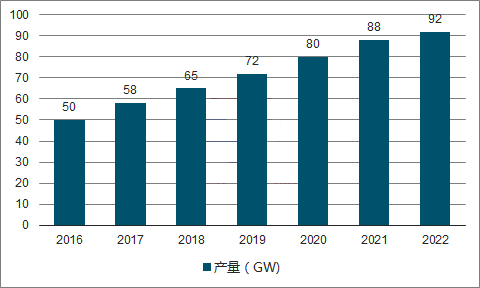
With the continuous development of science and technology,solar cellhas been widely used and promoted, and the demand in China is very large, and there is an upward trend year by year. Demand is expected to reach 58.02GW by 2022.
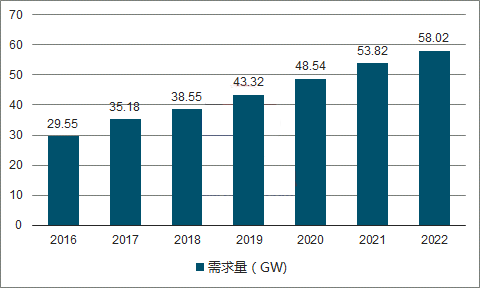
of our countrysolar cellindustry is facing overcapacity. Therefore, the solar cell industry needs to develop a diversified consumer market through close integration with related industries and its broad use. In 2015, the domestic component production capacity was basically the same as that in 2014, reaching 40GW. The further development of overseas markets such as Asia and North America will alleviate the problem of overcapacity. In the future, the supply of solar cells should show a relatively stable trend.



